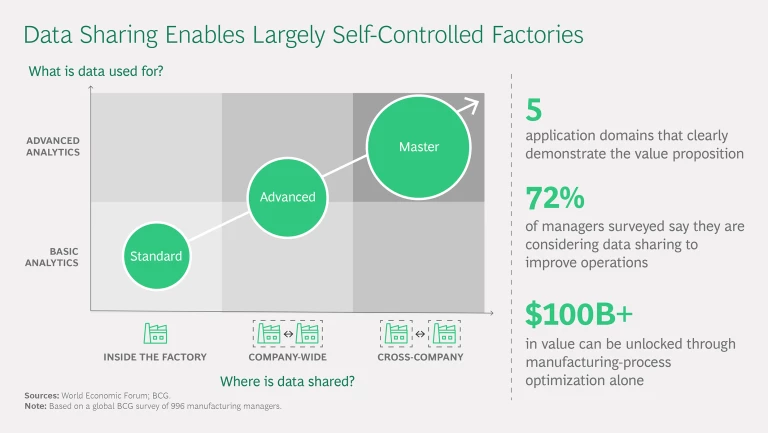Data is the lifeblood of the factory of the future. As manufacturers increasingly deploy advanced analytics, AI, and other emerging digital technologies to transform production and supply chains, they must find effective ways to apply and manage data. So far, most manufacturers have focused on data within their companies. By sharing data across companies, manufacturers can unlock additional value and accelerate innovation.
Nearly three-quarters of manufacturing managers worldwide are considering data sharing to improve their operations, according to a recent BCG global survey. The true masters of digitization use shared data not only to improve existing applications of technology but also to implement applications that would otherwise not be possible. The reward for exchanging data beyond the factory’s four walls is significant: the total value that companies can create in five key areas of data sharing is estimated to be more than $100 billion, focusing on operational improvements alone. (See the exhibit.)
A new white paper by BCG and the World Economic Forum investigates the application domains that can benefit from, or be realized by, data sharing across companies. The white paper presents common patterns in the applications, such as collaboration models, as well as the barriers to data sharing and the success factors for overcoming them. It also introduces a framework to help manufacturers select applications, identify partners, and discuss with them the ideal setup for their data collaborations. Finally, it outlines the key enablers of successful data sharing.
What Are the Applications for Data Sharing?
Data sharing in manufacturing creates value in five main application domains. (In the first domain discussed, data sharing enhances an existing solution for advanced analytics and AI. In the others, data sharing makes these application domains possible.)
Enhancing Asset Optimization. Combining data from multiple users of the same type of machinery allows manufacturers to improve algorithms that, for example, enable predictive maintenance. Sharing data can thus optimize asset performance by increasing machine uptime and product quality, creating a win-win situation for all stakeholders. This is particularly important for manufacturers that lack the amount of data needed to fuel robust analytics algorithms.
Tracking Products Along the Value Chain. By gaining end-to-end visibility into their value chains, manufacturers can react quickly to unexpected events and reduce inventory. Although manufacturers already track products along supply chains, they must collaborate, share data, and make use of common systems to establish true end-to-end visibility.
Tracing Process Conditions Along the Value Chain. Manufacturers can instill trust and more efficiently comply with stringent regulatory requirements by having access to a continuous and complete digital record along the value chain. This allows them to ensure that suppliers follow the agreed production processes and that suppliers can use these records as proof in warranty discussions. Companies in the food and pharmaceutical industries are already building data alliances to achieve these benefits.
Exchanging Digital Product Characteristics. Sharing data on product shape and composition allows manufacturers to synchronize and optimize connected production processes. A digital product twin that is shared between a supplier and an OEM can, for example, help to eliminate incoming quality inspections or topographical measurements needed to automatically process parts.
Verifying Provenance. Customers increasingly demand more transparency regarding where their products come from and how they are processed, and they want to verify authenticity. By sharing data, value chain participants can establish provenance and authenticity and help identify fraud. To enable this, each material and good needs a tamper-proof, unique identification that follows it along its production life cycle. Several companies have joined forces to collaborate on blockchain solutions that make this possible.
Collaborating to Promote Value
For collaboration on data sharing to be successful, stakeholders need a good understanding of how to promote value together. Collaboration can occur between manufacturers through a third-party solution provider, between direct suppliers and manufacturers in a supply chain, or between manufacturers through a machine supplier. Direct collaboration between companies in the same value chain step is rare given competitive and compliance challenges. For instance, two automotive OEMs will probably not share data on their products and production with each other directly, but if they wished to collaborate, they could do so through a third party.
The barriers to data-sharing collaborations are primarily trust-related and technical. From a trust perspective, a company may fear unintentionally giving away valuable or sensitive data about the business or losing negotiation power or a competitive advantage. Companies also may want to maintain visibility into how shared data is used and analyzed. Technical concerns include the risk of data breaches and losses, accessibility and interoperability issues, different digital maturity levels among participants in the same solution, and the costs of switching technologies (or fear of being locked into a particular technology).
Successful collaborations address these issues by developing a clear value proposition and rationale for data sharing, using mutually beneficial agreements, and applying secure technologies and common standards.
A five-step framework can help manufacturers initiate a data-sharing relationship. This framework does not cover all aspects of building a complex data-sharing collaboration. Rather, it is a starting point for an informed discussion on the data-sharing applications and building successful data-sharing relationships. This provides a basis for the partners to prepare their collaboration in detail. The framework includes the following steps:
- Understand the business challenges to be addressed by data sharing.
- Develop specific applications that address the business challenges.
- Prioritize applications based on business impact.
- Identify and assess partners for each application.
- Define the right setup for the data-sharing relationship.
When prioritizing data-sharing applications, it is essential to examine the value proposition and the risks as well as the data accessibility and quality. An assessment is needed to identify the right partners and understand the organizational and infrastructural readiness of all stakeholders. Finally, the parties need to discuss the requirements for the setup of the collaboration, sharing mechanisms, compensation model, and technology architecture, among other aspects.
After applying this framework, manufacturers still have a lot of work to do to prepare for the sharing of the data. Selecting the right technologies and using common standards help to overcome the main perceived barriers to data sharing, such as interoperability issues and risks. New technologies and the push toward industry-wide standardization and common reference architectures hold promise and should be further encouraged.
Every manufacturer has an opportunity to immediately start unlocking value through data sharing. To make it happen, leaders in manufacturing must establish a clear vision, develop the right value proposition, and select the right set of partners by building trust within their ecosystem. Once these prerequisites are in place, manufacturers can focus on overcoming other barriers to data sharing, such as security, privacy, and interoperability. By using a structured approach, leaders can identify relevant applications and establish successful collaborations. Despite many uncertainties, the recipe for success is clear: experts, industry participants, and governments must intensify their collaboration around data sharing to enable more manufacturers to become masters of digitization.
The full white paper provides a comprehensive discussion of the challenges and opportunities.







